At a glance, it would be easy to assume that short-haired dogs don’t shed much, as there’s simply less hair on the dog compared to their longer-haired counterparts.
But make no mistake, dogs with short hair do shed.
In fact, they can shed more than dogs with long hair, depending on the breed.
We learned this the hard way after adopting a short-coated Fox Terrier (cross). Cleaning up his loose hair was a never-ending job, especially since the short, needle-like hairs can be difficult to remove from the carpet, fabric, and car upholstery.
We’ve also discussed many other “short-haired shedders” on this site, and when you look at the facts, it’s clear that having short hair does not stop dogs from molting.
So, what’s the solution?
Assuming your dog doesn’t have a health problem, the solution to excessive shedding is pretty straightforward; it mostly comes down to diet and grooming, which we’ll discuss shortly.
And for those that would prefer a short-haired dog that is considered low-shedding, the good news is that they do exist. And in this post, we’ll show you what they are.
But before we get to that, let’s discuss how much short-haired dogs shed and some of the key differences between dogs with long and short fur, so you know what to expect.
How Much Do Short-Haired Dogs Shed (& Why)?
There’s no simple answer for how much short-haired dogs shed, as it ultimately depends on the individual dog breed. Some short-haired dogs shed very little (like the Italian Greyhound), and some shed a lot (like the Jack Russell Terrier).
That said, one thing that most short-haired dogs have in common is that they tend to shed more consistently throughout the year. Whereas many longer-haired dogs tend to shed seasonally, meaning they molt once or twice a year quite heavily.
What causes short-haired dogs to shed?
Virtually all dogs shed at least some hair; it’s just that some shed more than others. And one of the main contributing factors to how much a dog sheds is the hair growth cycle.
In short, dog hair grows in four stages (anagen, catagen, telogen, and exogen). Without getting too technical, the gist is that the hair grows, rests, falls out, and is replaced by new hair. And how quickly a dog’s coat moves through each stage determines the rate at which they shed.
Some dogs, like the Afghan Hound and Poodle, have hair that keeps on growing (like human hair). So it takes them much longer to complete this growth cycle than dogs with short hair.
Aside from that, there are a variety of factors that can contribute to shedding, which are explained in detail in the guide I just linked to.
For example, your dog’s health, the condition of their skin, allergies they may have, coat texture, and the season can all play a role in how much hair they drop.
Another thing to consider is whether or not your dog has an undercoat.
In other words, do they have one layer of fur or two?
The reason this matters is that single-coated dogs are less likely to shed seasonally and more likely to shed steadily throughout the year. And all else being equal, single-coated dogs can also be easier to brush, as you’re only brushing one layer of hair.
Anyway, this is basically just a long-winded way of saying that shedding varies from dog to dog, so it’s best to research the different dog breeds to get a better idea of what you’re up against.
What if you’ve already adopted a heavy shedder? We can help prevent you from asking the all too common question, ‘Why is my dog shedding so much?’.
There are some very simple, effective ways to manage shedding, which can save you a lot of time, effort, and frustration when it comes to cleaning up after your dog.
So, let’s discuss these now.
Solutions for Short-Haired Dog Shedding
It’s not possible to completely “stop” a dog from shedding, as this is a natural (and important) process. But you can get it under control. And for the most part, winning the battle comes down to optimizing your dog’s diet and establishing a proper grooming regime.
Diet
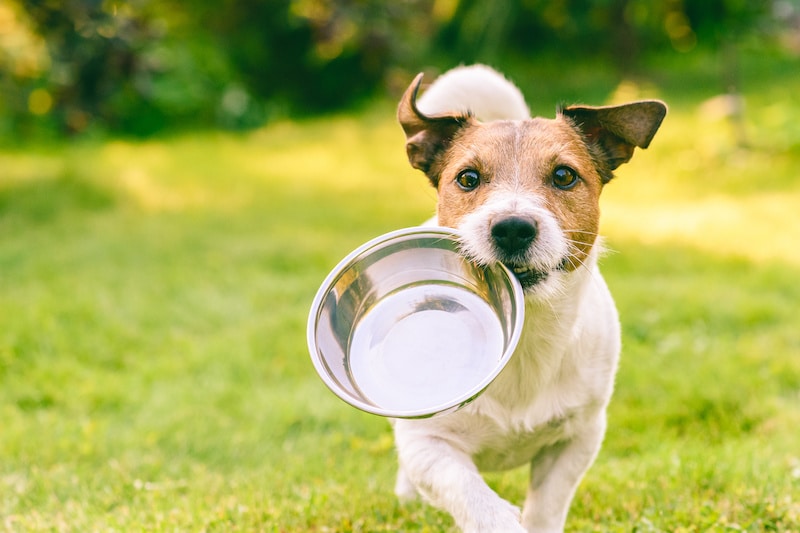
Ensuring your dog is enjoying a healthy, balanced diet can help him achieve optimal skin and hair, which in turn can reduce the likelihood of excessive shedding.
What sort of dog food is best for a healthy coat?
Ultimately, the best person to speak to regarding your dog’s diet is a veterinarian, so if you’re not sure what’s best for your dog, I would recommend speaking with a qualified vet.
That said, generally speaking, some dog foods are better than others, and it’s best to go with higher-quality kibble that is designed with a dog’s skin and hair in mind.
For example, some dog foods are specially formulated to help reduce excessive shedding. These typically contain healthy omega-3 fatty acids and other natural ingredients that are known to help improve a dog’s skin and hair.
Also worth mentioning is that dogs can have a reaction to the chemicals, preservatives, and colorants (among other things) found in many cheap kibbles on the market. And one of these reactions can be skin irritation, which in turn can lead to scratching and excess hair loss.
As with many so-called shedding supplements, there is no such thing as dog food that will completely eliminate shedding, but good quality kibble can reduce the likelihood of unnecessary shedding. And that’s good news, since feeding your dog the optimal kibble is a very simple shedding solution that shouldn’t require any change to your daily routine.
Brushing
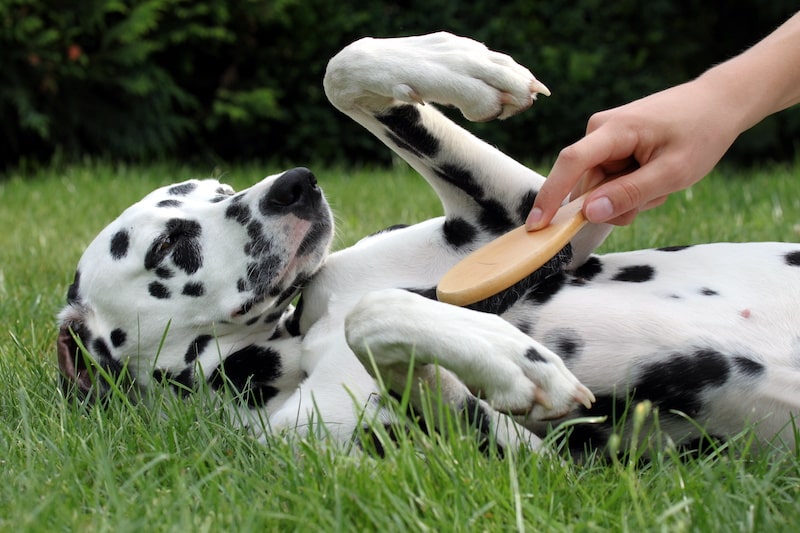
One of the best things about short-haired dogs is that they’re usually way easier to brush than dogs with long hair. They typically only need to be brushed once or twice a week, whereas many long-haired dogs can require daily, time-consuming brushing sessions.
In any case, brushing is one of the best ways to limit shedding.
Not only can this help remove the excess hairs before they drop onto your floors and furniture, but brushing can help spread your dog’s skin oils, which is great for their coat.
A very common question we get is: What sort of brush is best for short-haired dogs?
The best type of brush for a short-haired dog is a bristle brush or curry comb (rubber brush), as these are designed for dogs with short coats.
However, if your dog is prone to shedding, a de-shedding tool may be worth investing in because these are specially designed to remove loose dog hair.
And of all the de-shedders we’ve looked at, our top pick is the FURminator.
This tool comes in a range of sizes that suit any coat length, and while they are typically more expensive than most regular dog brushes, they make removing the old fur quick and easy.
I wouldn’t recommend brushing with a de-shedding tool, but a good session with a FURminator (or similar) once or twice a week can make a world of difference.
Bathing
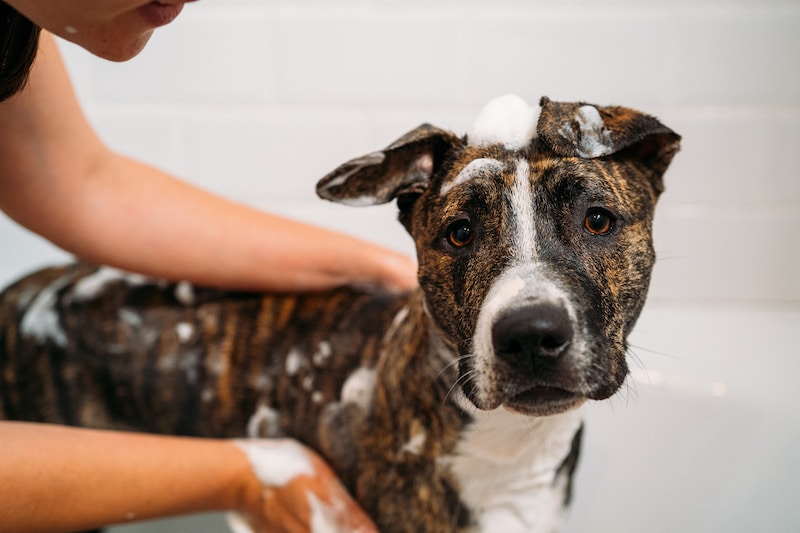
Bathing your dog once a month or so is an excellent way to limit how much loose hair you need to clean up, and it’s the perfect way to complement your brushing routine.
As with choosing a good dog food, however, it’s important to select a good quality dog-friendly shampoo. This is because human shampoos (and dog shampoos loaded with harsh chemicals) can strip your dog’s coat of its natural skin oils, which can lead to dryness and irritation.
And if that happens, you might find that the shedding actually increases!
So, it’s worth using the right shampoo.
And if you want to “supercharge” your dog’s bathing session, consider using a dog hair blower instead of a towel when it’s time to dry your dog, as these nifty tools do a great job of blasting away the old, excess hair off of your dog after a bath.
Not only can blow-drying save you time compared to towel drying, but it can reduce the time you spend brushing your dog (which is why many professional groomers use them).
Anyway, those three things (diet, brushing, and bathing) can go a long way to helping you reduce your dog’s shedding. And if you want to know more, check out our complete guide to reducing excessive shedding, as it’s loaded with even more shedding solutions.
Recommended: Go here to see our top-rated dog hair blow dryers
Are There Any Low-Shedding, Short-Haired Dogs?
Yes, low-shedding dogs with short hair do exist.
Unless you’re planning on adopting a hairless dog, there is no escaping the fact that virtually all dogs shed, but some short-haired dogs shed very little hair, like those listed below.
- Redbone Coonhound
- American Staffordshire Terrier
- Vizsla
- Miniature Pinscher
- Cane Corso
- Boston Terrier
- Italian Greyhound
- Whippet
- Basenji
- Rhodesian Ridgeback
- German Shorthaired Pointer
Not only are the above dog breeds low shedders, but thanks to their short coats, grooming them is a cinch. So they are about as low-fuss as you can get. I have a German Shorthaired Pointer cross currently and he is an easy guy to groom!
Another common question we see is: Are there any hypoallergenic low shedding dogs?
No dog is truly hypoallergenic because the most common dog allergy trigger isn’t the hair itself; it’s a dog’s dander (dead flaky skin). And since all dogs produce dander, there is no such thing as a completely hypoallergenic dog.
That said, some dogs are generally more tolerable among allergy sufferers, and they tend to be the breeds that shed very little. This is because dander (and other allergens) stick to dog fur, so the less hair there is floating around your home, the better.
Anyway, of the above list, the Italian Greyhound is one of the more “hypoallergenic” breeds. And if you’re looking for more ideas, these dogs are often described as hypoallergenic.
Recommended: Go here to see our top-rated dog hair blow dryers
Conclusion
You might be surprised to learn that some short-haired dogs can shed heavily, but thankfully, it’s not hard to get under control, especially since short-haired dogs are very easy to brush.
Not to mention, unlike long-haired dogs, their coats aren’t prone to mats and tangles. So they don’t require daily brushing, which is a huge plus if you’re looking for a low-fuss dog.
In some cases, shedding can be the result of a health issue. So if you have any concerns at all, it may be best to speak with a veterinarian. But in most cases, shedding is normal, and with the tips in this post, you should be able to win the battle once and for all.
At the end of the day, if your short-haired furbaby sheds a lot, you may need to spend a bit more time brushing than usual. But this will likely pale in comparison to the effort needed to groom many popular “non-shedding” (long-haired) dogs like the Poodle or Bichon Frise.
So, in the end, it’s somewhat of a tradeoff.
Of course, if you want the best of both worlds, then the good news is that short-haired low-shedding dogs do exist, and the breeds we mentioned earlier fit that description.
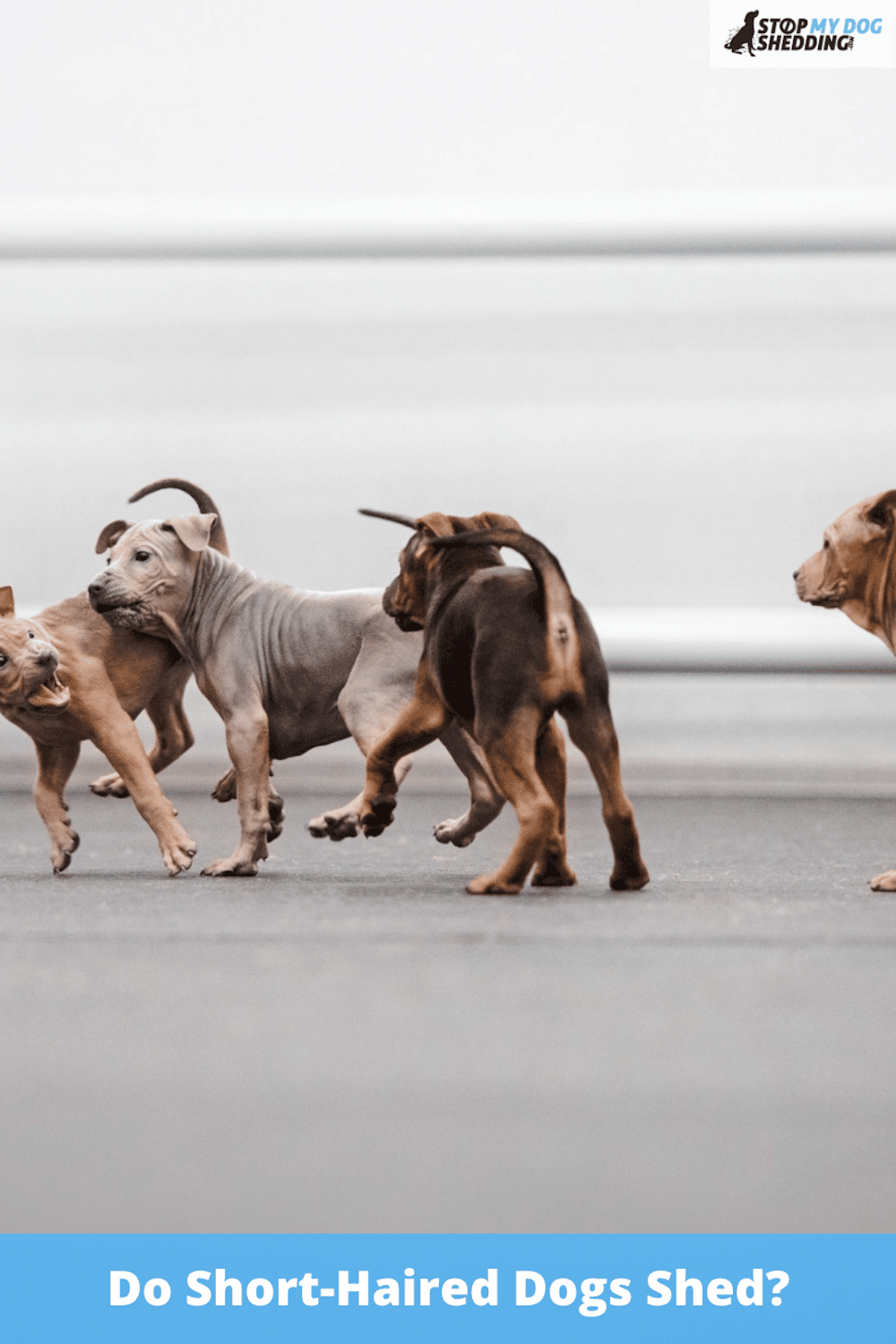

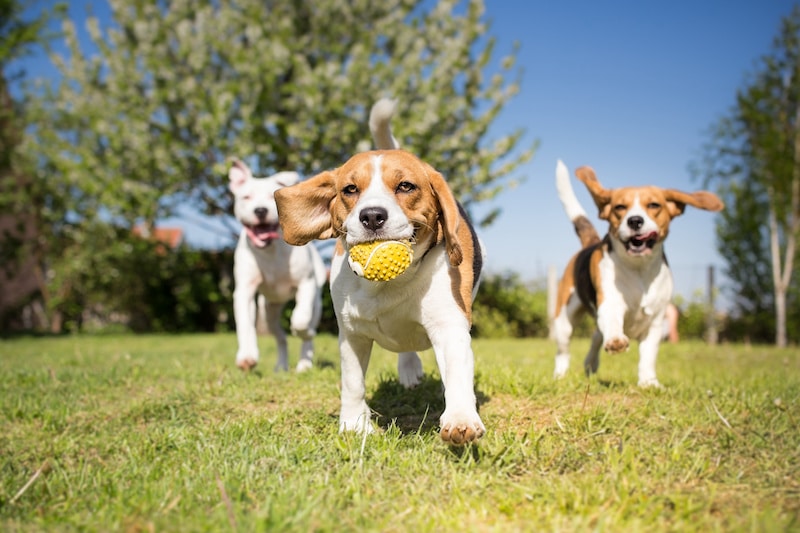
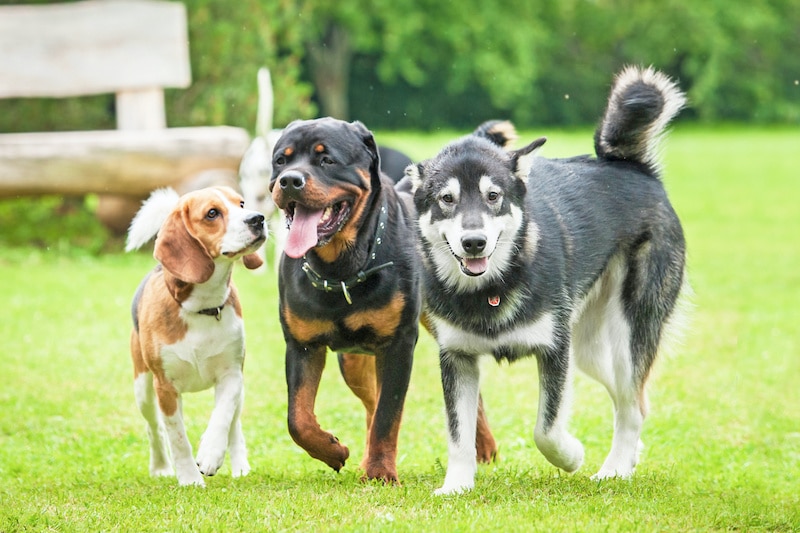
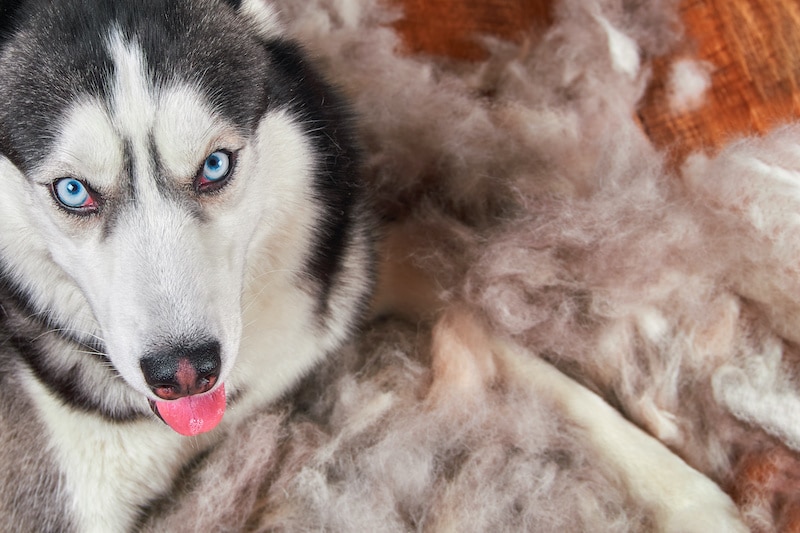
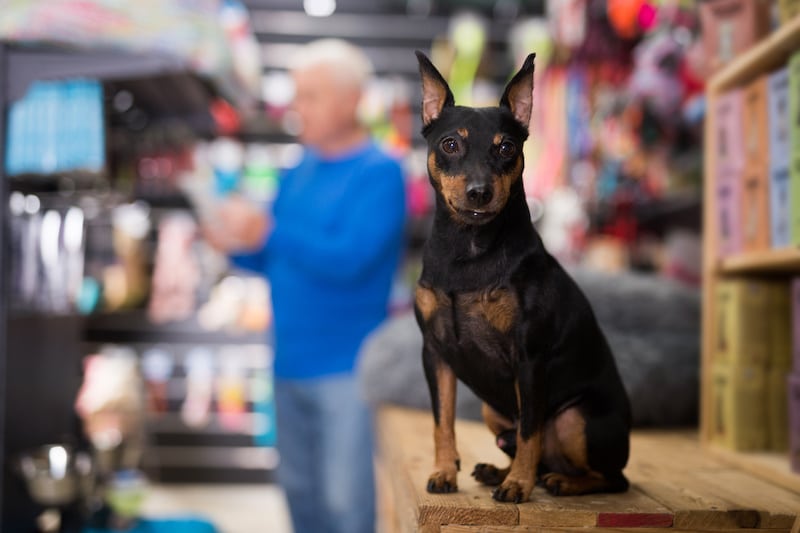







Please note: By submitting a comment using the above comment form, you confirm that you agree with the storage and handling of your data by this site as detailed in our Privacy Policy.